GEAR GUIDE
My Travel Gear
Welcome to my travel gear list. Below you will find most of the gear I use for my travels. I have come up with this list of items over the years and it has served me well. Should you be using everything I do? No, of course not. But I feel that this is a solid enough list that it very well may help steer you in one direction or another.
Everything listed is high-quality and durable. I do an exorbitant amount of research on everything I purchase.
I’ve had friends tell me they are never going gear shopping with me again.
There’s nothing worse than being on an adventure and having something fail or not fit right.
I’d also like to say that none of this gear is sponsored. If you notice any brand trends it’s because they’re a company I have grown to trust.
Camera Gear
Sony a7R IV

I’m not going to spin you, this camera is a heavy hitter and it’s probably way more than the average person needs.
As I’m primarily interested in adventure travel, lugging around a giant DSLR camera felt impractical. Hiking at high altitudes for an extended period of time, you want to minimize weight.
It’s because of that I ended up looking at mirrorless options.
Initially I purchased the Sony A7 III. That camera is an amazing, low light and video beast! But I don’t shoot much video so when Sony announced this full frame 61.0MP monster I was all in.
Now if I could only get around to making some of those prints I have planned to make full use of it!
Sony 16-35mm

This Zeiss lens is probably my favorite. It’s super wide angle and boy do I love me some wide angle pictures! I just wish I bought it sooner. No, it’s not cheap but good lenses never are. It depends on the situation, but I keep this on my camera probably 75% of the time.
I am however planning on upgrading to the Sony 16-35mm GM in the near future.
Sony 24-105mm

I have to say, I couldn’t be happier with this purchase. It’s sharp, light, and has a good range.
I chose this G-lens over the GM 24-70 f2.8 for a few reasons. First, and foremost was the staggering amount of reviews that complained about both the size and the weight of the GM. Second key factor was the extra range from 70-105mm since my telephoto starts at 100mm.
Sony FE 100-400 GM

I LOVE this lens. This thing looks beautiful and takes beautiful pictures. I can’t even express how much I love it for photographing wildlife. The only drawback is that it weights a lot.
The 100-400mm range is ideal for a safari. Then, should you choose, you can throw on a teleconverter for added range. I recommend the 1.4x teleconverter which will bring your reach up to 560mm. I’m personally not fond of the 2x teleconverter because you’re losing a lot more light.
Since it weighs over three pounds, when bag weight or space become an issue, it’s usually left behind unless I’m going somewhere that specifically calls for it.
DJI Mavic Pro 2

I love drone photos so of course I had to get arguably the best one on the market for travel. (At the time.)
With a Hasselblad camera sporting a large 1 inch sensor that takes 20mp photos and a compact size, this drone is a travel photographer’s dream.
I like to put this in the air whenever I get the chance but be sure to follow all of the rules for wherever you’re going. Some foreign government’s have vastly different drone laws than we do in America.
These laws can net you a considerable fine if you’re caught breaking them. A man in Taiwan was fined $20,000 for flying a drone into a restricted area twice!
Should you purchase from Amazon be sure to check out the different package deals that include extra accessories for roughly the same cost. These bundles change often so try to find one with an extra battery if possible.
DJI Mini 2

Because why buy one drone when you can buy two?
Super light and legal pretty much everywhere in terms of size, this is a fun drone to have.
It takes great pictures and records in 4K so I’ll bring this with me on hikes and longer trips where I can’t manage the weight of my larger Mavic Pro 2.
Benro SLIM Carbon Fiber Lightweight Travel Tripod

I’m not the biggest fan of tipods as they’re bulky, add unwanted weight, and slow things down. But every now and then, I do need one. Sometimes while traveling solo they’re a necessary evil.
I chose this tripod because at the time, it was one of the lightest on the market. This the only tripod I’ve ever used and I’ve had no complaints with it.
If I used them more often I’d probably upgrade to the Peak Designs Carbon Fiber Travel Tripod but I don’t, so this will do!
Batteries

Always bring extra batteries with you.
There’s nothing worse than missing the shot because your battery died on you.
I usually bring three for my camera and three for my GoPro.
I don’t shoot video so I’ve found that to be plenty considering I’ve spent extended periods of time without access to electricity.
Just be sure to charge them when you can.
Essential Travel Gear
Colored Dry Bags
I prefer dry bags to store my clothing and loose smaller items. They compress well (If it’s clothing I lay or sit on the bag before rolling the end down) and will keep your belongings dry in the event of rain.
Different colors also tell you which bag has what type of item so you don’t have to go digging through every single one looking for a AAA battery.
I currently use Sea to Summit Ultra-Sil Nano Dry Sacks. These are a bit more pricy than some other options out there, but for how super light they are, I’ve found them to be extremely good and I’ve yet to have one rip. There is some debate as to their waterproofing capabilities, which I can understand as they won’t hold air as a pillow for hours at a time. They will however compress with clothing and keep the air out, and I’ve used them to do my laundry without any water leaking through.
If I’m doing something where I’m anticipating anything more than rain, such as kayaking, I’ll use the sturdier Sea to Summit Lightweight Dry Sack, All-Purpose Dry Bags. They do make an even heavier version than this but I haven’t found it to be necessary.
Packing Cubes

When stuff getting wet isn’t a concern, I use the Travelon Packing Cubes. They’re lightweight with a rip-stop bottom and have piped material along the edges that help them to hold their shape.
A mesh top allows you to see what’s inside of each cube without opening it.
These cubes are all essentially the same. I use these primarily because they were the first three pack I found.
Luggage Locks

If someone really wants to get in your bags, they’re going to get in your bags. But 99% of the time, a simple luggage lock will be enough to dissuade them.
The average airport or hostel thief wants to be in and out of your stuff before someone catches what they’re doing.
The best defense however, is to not leave valuable items unattended. If I ever need to leave my camera at the hostel, it’s constantly on my mind. (I hide my SD cards when forced to do this)
Make sure all locks you purchase are TSA approved so airport screeners wont destroy your bag if they ever need to search it.
Mini FlashLight

Don’t be the dick who turns on the room lights at 3am while everyone is sleeping. If I’m staying in a hostel I always have a mini flashlight in my bag just in case I need to look around for something in the dark.
These come in handy and are both stronger, more focused, and easier to manage than a cell phone flashlight.
Keep it in your day bag. You’ll never know when you might need it.
Power Adapters

I don’t own a giant universal power adapter like everyone else. Why not? Because they’re usually large, heavy, and unwieldy.
USB plugs however, are pretty much universal worldwide and most male plugs now a days have a USB port. As such, I just buy a local plug upon arrival and use my own USB cable with it.
Fair warning, the voltage probably doesn’t match up. I’ve never had a problem with it but do this at your own discretion. If you fry something, it was your call.
Pocket Knife

“Always carry a knife with you, just in case there’s cheesecake, or you need to stab someone in the throat.”
-General James Mattis
I’m not a believer in heavy multi-tools such as the leatherman. Instead, local laws permitting, I carry a pocketknife whenever I travel.
Normally I opt for one that’s small enough to never give me worry over local size limitations.
My go to knives are the Spyderco Dragonfly 2 Salt and the Spyderco Paramilitary 3
The Dragonfly is made of H1 Steel and completely rust proof. Because of that I take it whenever I go diving as well as wherever I can’t bring the paramilitary which has a larger blade.
All of my knives are made by Spyderco which is a very popular brand. As such, there are fakes aplenty out there so be sure to purchase from a reputable dealer and if purchasing online, check YouTube for comparison videos to help spot any fakes.
Hanging Toiletry Bag

If I bring any toiletries beyond a toothbrush, this is what I carry them in.
These bags are essential if you’re staying in a hostel. Showers can get pretty dirty when 50 people are sharing them so you’ll want to keep your stuff off the ground and shelves.
If you don’t want this specific bag, just make sure that whatever you purchase has a hook. That’s the key component. Otherwise what’s the point?
If I’m traveling super light I’ll usually buy one small bottle of 3 in 1 hair, face, and body wash because it saves so much space. I know this will probably trigger a few people because I always get flack for even using 2 in 1 shampoo and conditioner. Take that, $200 shampoo user!
POWERADD EnergyCell Ⅱ 10000

Anker has a pretty firm grasp on this market, and I do have their 10000mAh power bank, but it started to degrade quite rapidly.
I almost bought another but they haven’t updated their design in so long that it still used micro-USB ports for charging. Unacceptable.
This Poweradd power bank supports USB-C to USB-C charging as well as USB to USB-C so that was all I needed to make up my mind.
It lasts long and charges in only a few hours.
Can’t go wrong with this.
Bags
Atlas Athlete Camera Bag
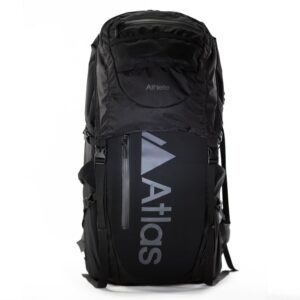
Currently my main camera bag and in my opinion, damn near close to the best camera bag for an outdoor enthusiast.
Built like a day pack, it has a unique origami compartment for your camera equipment that you can expand and contract based on how much camera gear you want to bring with you.
I like this bag so much that I’m planning on doing a complete write-up on it. National Geographic likes it too because they awarded it the title of “Best Camera Bag for Travelers.” This bag comes in two sizes. The smaller Athlete which I use, and the larger Adventure.
Osprey Farpoint 55 Travel Backpack

The Farpoint 55 is my workhorse for general travel and what I bring when I won’t be married to my bag. Backpacking across Europe? Yes. Camping or trekking? No.
With a stowaway back panel and a zip off day-pack, this bag fits everything you’ll need for pretty much any trip. I have put this bag through the ringer and it’s still going strong but should a problem ever arise, it’s covered by the Osprey All Mighty Guarantee.
While this bag appears somewhat large at 55 liters, that includes the zipoff pack which is 15 liters. So with that detached, it’s only a total of 40 liters.
What I like to do is take the day-pack off and stuff it inside of the main bag. Once I’m on my trip I then use the daypack for any overflow that I might accumulate such as clothing or souvenirs. This also comes in a larger 70 liters but the extra space is unnecessary in my opinion.
With the day-pack removed this bag will also fit most carry-on requirements. Don’t ask if it’s small enough, just do it. You’re far more likely to get it through as a carryon. I’ve only ever been told no once and that was when I directly asked if it was small enough.
There is a women’s version. the Osprey Fairview which provides a different anatomical fit.
Osprey Kestrel 48

Wearing this bag on your back is like wearing nothing at all. Osprey knows quality and the hip-belt is the most comfortable I’ve ever used. I purchased this bag for use as my day pack on Kilimanjaro and it was a dream to wear.
While it is a bit larger than recommended for Kilimanjaro, I needed a little extra space for camera gear as my bag had to fit any necessary camera equipment for a safari the following week. That included my 100-400mm telephoto lens which weighs over 3 pounds.
A smaller, 38 liter option (better for Kili) exists as well as the Osprey Kyte which is the female version.
The North Face Basecamp Duffel
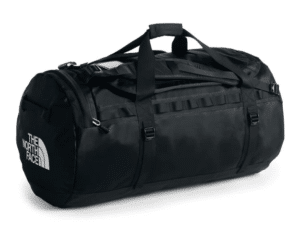
I did a ton of research while trying to choose a duffel bag for Kilimanjaro. And when I say a ton, I’m not talking hours. I mean days.
I watched every video, read every article, and visited every store that sold duffels.
Luckily it took me as long as it did because TNF released an updated version of the Base Camp the same day I was going to finally place my order.
I’m not joking. THE EXACT SAME DAY. I powered up my laptop, and when I opened my browser, “BASE CAMP DUFFEL—L UPDATED DESIGN” with a new picture was staring at me.
This bag is bomber. And while it isn’t fully waterproof, it’s going to keep your stuff dry. The main selling point for me was the separate compartment that’s designed for keeping things like shoes or dirty clothing separate.
I purchased the large which is 95 liters but it comes in 6 different sizes: 33L, 50L, 69L. 95L, 132L, and 150L. Be sure to check which bag you’re purchasing as most amazon sellers have yet to update their offerings. The updated version has the side compartment and a daisy chain that goes along the entire side like in my picture.
I’ve never had it packed tight and probably could have fit all of my Kilimanjaro gear in the 65L, but I like having the extra space.
Nomatic Peter McKinnon

This isn’t just a camera bag so much as it is a photography travel system. If you’re a photographer and like traveling carry-on only, this is the bag for you.
35L and expandable to 42L, it was designed for a photographer to be able to bring all of their gear as well as any necessary travel accessories.
I’ve used this bag to fly carry-on only to several countries.
Too big to use as an every day bag? No worries! It has a removable camera cube that converts into a lightweight day bag!
Lowepro Photo Hatchback
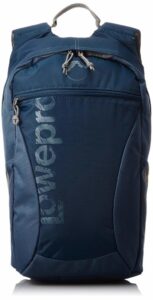
This is the smallest bag that I own and while I do like it a lot, I’ve long since reached the point where I have outgrown it in terms of how much photography equipment I carry.
It’s best suited for light day trips or walking around in a city.
I’ll still remove and use the camera cube from it on occasion but only in cases where I can fit that inside of a larger bag.
Action Camera Gear
GoPro Hero 10 Black

My action camera of choice, I’ve been a GoPro user ever since the Hero 3 Silver+
Not only are these perfect for action sports, but they’re also small and discrete enough where you can use one in some of those “No Cameras Allowed” moments. The majority of pictures I took on the Trans-Siberian Railway were taken with my GoPro because the attendants were quite strict with their no photo policy.
I currently use the Hero 10 Black which is so far pretty bomber. The Hypersmooth 4.0 is leaps about my old GoPro which was the Hero 7 Black. The final test will be my upcoming dive trip which was my primary motivation for the upgrade.
GoPro Super Suit

I know the Hero 6 and Hero 7 Series of GoPro cameras are supposed to be waterproof but I’ve heard plenty of stories about people ruining them with water damage.
Plus, their water resistance isn’t meant for diving so if you want to go deeper than snorkeling depths you’ll want a Super Suit. I use one in any depth of water.
These also help if you’re doing something that might damage your camera. (Provided you’re concerned with something like that.)
GoPro Evo

I don’t really like selfie sticks but for some activities such as diving and snorkeling, they’re a necessity. Since I only really use it in the water, I chose the GoPole Evo for it’s air filled, floating design and clear, unobtrusive look.
Once you’re in deep water it will fill halfway, in fact it’s best to aid it by opening and closing it a few times so it doesn’t compress on itself, but it will still retain some buoyancy.
There is a longer version as well, the GoPole Reach.
GoPro Jaws Flex Clamp
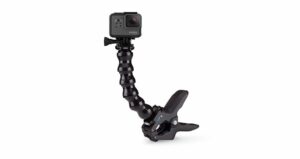
These clamps are great for attaching your GoPro to a vehicle, bike, tree branch, whatever. It removes the need to hold your camera and frees you to better enjoy whatever activity you’re participating in.
I really could have used this on the Trans-Siberian Railway but had left it at home. I ended up holding my camera out the train window for thirty minutes to shoot a time-lapse in the Gobi Desert… twice.
A good trick is to remove a few links form the adjustable portion as this will remove a good deal of vibration shake while still allowing you to position the camera.
GoPro Sticky Mounts

I don’t use these often but boy do they come in handy when you need them!
Designed to be disposable and easy to remove with a little heat from a hairdryer, these are used to mount your GoPro to just about anything.
They come curved for mounting to something like a helmet, or flat for mounting to just about anything else.
Snowboard, surfboard, kayak, car hood, you name it!
Polar Pro Red Filters

Red filters are a handy GoPro accessory for underwater photography.
I’m sure you’ve all seen underwater photographs where everything looks green or blue. Well, after you get below ten or so feet of water, red light starts to get filtered out and disappear. These filters help correct the lack of available red light and give you a more natural looking photograph.
Travel Clothing
Arc'teryx Cerium LT Jacket

I love all things Arc’teryx.
With 850 down fill power, this is a warm jacket. Don’t confuse it though, it’s not a parka. While you can wear this on its own, and look great while doing it, these jackets work best in conjunction with a hard-shell over top.
I bring this jacket with me whenever I’m going somewhere outside of the summer season because you never know. I was in Barcelona and temperatures were in the 90s but 2 weeks later in Vienna, it was around 40 with cutting winds. You never know.
Should you prefer, there is a hooded version as well. Which I also own, in red.
Arc'teryx Zeta SL Jacket

Waterproof, windproof, bombproof, and breathable. This Super Light (SL) Gore-Tex jacket is the gold standard of keeping you dry. I did a ton of research on waterproof hardshells and the Zeta SL won the prize.
I wore this on my Kilimanjaro ascent and while it didn’t rain, it kept me shielded from the relentless wind on summit night.
The storm-hood was clutch because it allowed me to shield my neck and head. I don’t think I could have been any happier with this purchase. Lightweight and highly packable, you can take it anywhere.
Columbia Men's Silver Ridge Shirt

The type of shirt I bring depends on where I’m going, and what I’m doing. Lots of sun and extended periods of time outdoors? I burn easily so I like the Columbia Silver Ridge with Omni-Shade technology.
Lightweight and moisture wicking, these shirts will help you stay cool, dry, and unburnt.
If short sleeves are on the menu and I’m hiking, I’m fond of anything performance. One such shirt I like is the Columbia Men’s PFG Zero Rules shirt. I own several others by LL Bean and The North Face but I’m not going to list everything so if you’d like to know, feel free to ask.
If I’m just cruising around a city somewhere I’m most likely in a regular cotton shirt. But for the love of all things… if you’re trekking, leave the cotton at home. I can’t even express how lucky the Australians on my Kilimanjaro trek were that it never rained.
Heavy cotton sweatshirts, sweatpants, and t-shirts at altitude?? I almost choked when I saw them. When cotton gets wet at altitude it’s almost impossible to dry. “You really should have done your research.”
Columbia Men's Silver Ridge Cargo Pants

Over the years I’ve done a lot of shopping for the perfect travel pants. I’ve pulled up every article titled, Best Pants for Travel, I’ve tried on dozens of styles, looked at them under microscopes, and these are what I settled on.
They fit perfectly, are lightweight, moisture wicking, dry fast, and offer Omni-Shade sun protection.
Another key feature that I wanted is they have one regular cargo pocket, and one zip cargo pocket. I like zipper pockets for the extra security they offer and the regular for being able to freely drop something into it. The best of both worlds.
I almost never wear shorts but should you desire, there’s a zip off convertible version as well.
PSA: Don’t hike in jeans. Ever.
Darn Tough Merino Wool Socks
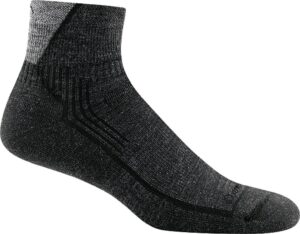
I own about 10 pairs of these in pretty much every style. Wool socks are like a dream when worn day to day but when you’re hiking or backpacking, they turn into an essential.
If there’s one thing I’m going to stress, it’s take care of your feet. These wool socks are soft, comfy, wicking, fast drying, and antimicrobial. That means your feet are less likely to stink after you’re done wearing them for the second (or fourth) day in a row if you’re backpacking and have no access to a washing machine.
Darn Tough also offers a lifetime guarantee on their socks so don’t worry if you wear a hole in the toe.
Smart wool makes good socks as well and I own two pairs of their heavy mountaineering socks for cold weather.
Arc'teryx Men's Birdcap

I usually wear a hat while traveling. First it was one by Hurley which for some inexplicable reason, EVERYONE in Peru wanted to buy from me. I ruined that hat in the ocean so now I wear the Arc’teryx Bird Cap. I like this hat because of its low crown. Most hats fit like an Abraham Lincoln stovepipe hat on me, but not this.
If you look at my pictures, yes it does appear different. I took a white paint pen and colored in the logo because you couldn’t see it and straight black was too plain for me. There you go, Arc’teryx. I fixed the black version of your hat. Sponsor me?
As soon as it starts getting cooler I have a blue wool hat with birds on it that I like to wear. Unfortunately I don’t have any links for it because they’re handmade in Germany for sale in Switzerland.
If the shop owner is to be believed, you can only buy them in Mürren… for an exorbitant $50. Normally I wouldn’t have paid that much for a hat but while trying to get a haircut, the plastic length guard fell of and I got buzzed. Wasn’t happy.
Trekking or Camping
Black Diamond Storm Headlamp

This headlamp is powerful, waterproof (1m for 30 minutes) and dustproof. On Kilimanjaro, it was hands down more powerful than all the others in my group combined. While I was in the front of the line my guide didn’t even turn his on.
While I love powerful flashlights, sometimes you just need the free hands.
I have seen some people complain about battery life but I have yet to have any issues and find my expectations to match with the Outdoor Gear Lab test results. I put in fresh batteries for summit night and they have lasted well beyond that.
Hyke & Byke Eolus

This bag is toasty! Warm and light with great compression that won’t break the bank. For this price point, you’re not likely to find much better.
Sleeping on my side isn’t an issue and I am yet to have a single feather poke through.
I’ve taken this bag everywhere and I’m yet to be cold while in it. They say you should have a zero degree bag on Kilimanjaro and while they do make one, I brought the fifteen degree bag with me and was fine. *Disclaimer* I know everyone likes to think they’re a warm sleeper, but I turn into a living meltdown when I sleep. I put off so much heat that I’ll wake people up.
If you’re climbing Kili, buy the zero degree bag. It is extremely cold and I won’t be responsible for your freezing.
Black Diamond Alpine Carbon Cork Trekking Poles
![]()
Do you love your knees? Consider investing in trekking poles. These can be a life saver in more ways than one. Not only do they help with the impact on your joints (especially during a steep downhill) but they’ll also help you if you slip. I have avoided several falls because of these.
They’re also great if you ever feel the need to ride the pony.
Salomon Quest Prime GTX Hiking Boots
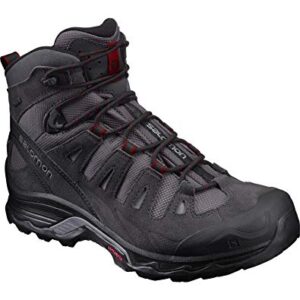
Like most people, my feet are slightly different sizes. As such, I was running into some difficulty in finding hiking boots that fit me well.
These waterproof Gore-Tex boots were near perfect. I wore them on Kilimanjaro where they kept me stable, warm, and dry straight through summit night. I then wore them the following week on a safari without my feet overheating.
They also make a women’s version.
Ironlace 550 Paracord Boot Laces

I re-lace all of my boots with 550 cord and you should too. Paracord 550 Type III is known for being extremely durable and strong
To rattle off a few of the benefits over traditional laces, they’re not going to break on you, are rated to hold 550 pounds, and each lace contains 7 inner strands that hold 35 pounds each. These can be removed for any number of survival applications.
Since they’re a soft nylon you will need to double knot them while using a standard loop shoe tie. By double knotting I’ve never had them come untied on me.
Fire-Maple Woodpecker Titanium Spork

The perfect size for eating a backpacker meal or MRE without needing to reach inside of the bag.
At 7.2″ I’ve been trying to find a titanium spork in this length for a while. This is almost exactly what I was looking for. I also love the hook end which while designed as a hole punch for fuel canisters, can also be used to hang it from your meal bag or to open a beer.
My only complaint is that the bowl isn’t polished. Makes it a little harder to clean and stuff may stick to it a little more but that’s not a huge deal. (It could also be a little narrower.)
Tenacious Tape

Ever rip a sleeping bag or a down jacket? It can be a mess of feathers, and possibly ruin your trip. I’ve never been on the receiving end, but having seen it once, I now always bring a bit of Tenacious Tape with me whenever I’m doing anything that involves down or a tent.
This tape has an aggressive adhesive that sticks to almost any surface and can be used for a variety of flexible, long lasting repairs.
It instantly seals leaking seams, tears and pinholes; stops rips from spreading and acts as an abrasion-resistant shield on high-wear areas.
It’s cheap, light, and takes up no space. Just be sure to get the colored and not the clear tape. The colored has fabric integrated into it while the clear is more plastic like and will crinkle on you.
